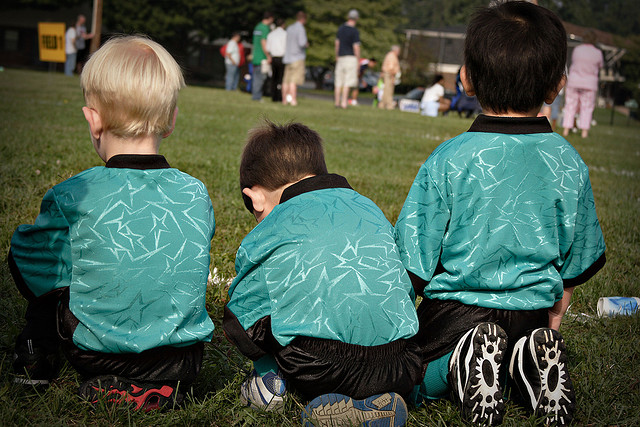Association of Chartered Physiotherapists in Sport and Exercise Medicine blog series
By Sam Blanchard, @SJBPhysio_sport
Head of Academy Physiotherapy at Brighton & Hove Albion FC. South-East representative for ACPSEM
Recently I stumbled across one of those rare beauties of a course that grips you from beginning to end, where everything relates to previous clinical experiences. I sat for hours absorbed by Sid Ahamed, nudging my colleague with a grin on my face – “that’s what we saw”, “that makes sense now” the whole time she was replying “shhh, I want to listen to this bit!”

The course itself was based on musculoskeletal conditions in young athletes, something that I have “fallen into” in my career. I never set out to work solely with kids and I think this is something that is reflected in the profession of physiotherapy as a whole. It is not taught in any detail at university, and there is a distinct lack of specific CPD courses on MSK Paeds. I always thought working with children would be a stepping stone to working with elite athletes. It is only since working with young athletes however, that I have discovered the unique challenges and variations in conditions that you would not necessarily see in skeletally mature athletes.
The ‘Worst Case Scenario’ Approach
I teach my staff to consider an 8 year old, a 14 year old and a 21 year old footballer as 3 different species all together. Ahamed says “They are not just mini-adults” and this is a great mind-set to have when assessing and diagnosing. The “easy” diagnoses that we see commonly in the treatment room are the enthesopathies that everyone associates with paediatrics & football – Osgood-Schlatters and Severs – both forming the cornerstones of our injury audit each year. However, the more tricky pathologies that often get missed are the ischial tuberocity apophysisitis, presenting as a proximal hamstring tendinopathy in the “bigger species”. Or the Slipper Upper Femoral Epiphysis (SUFE) going undiagnosed as “it’s probably just overuse, or a sportsman’s groin”.
The approach we now take within our academy is to think worst case scenario first – what’s the most traumatic thing this presentation could be? What bony landmark does this muscle group attach? Lesser trochanter of femur? Well it’s probably an avulsion then, not a psoas tendinopathy.
If a player in the under 14s suffers an inversion mechanism of the ankle, we always treat as a fractured fibula until proven otherwise. Even with a negative X-Ray, it’s worth considering the weakest link in all of the structures involved and for most pubescent athletes, that’s the soft, cartilaginous epiphysis (2-5 times weaker!) rather than the strong tensile ligaments and tendons (Caine et al 2006).
Unique management strategies for young athletes
But so what? How does the management of these conditions, with very similar presentations between adults and children, differ? The first thing is the patience and over-cautious approach to the initial assessment. If you see what you would suspect to be an MCL strain in an adult, and you know that a skeletally immature patient is weakest at the bony attachments, would you still perform a lateral stress test? You know the mechanism of injury, you can see effusion, you have noted pain on palpation of the medial femoral condyle – stop there! Go straight to the POLICE (Bleakley, C; Glasgow, P & McAuley, D. 2012) (New PRICE guidelines available HERE). By performing a stress test, the only thing you may learn is the stability of the potential avulsion fracture of the medial femoral condyle. And by determining this stability, you won’t change your treatment. The clinical decision now is whether or not to refer for imaging. At some clubs, in some sports, this may be a very routine practice. At others this may require a very good relationship with the local A&E.
The second difference would be the decision of when to progress exercises. Again, what may present as a tendinopathy in an adult is probably an apophysitis or avulsion in a young athlete. Rather than considering eccentric exercises to load the tendon, you are more likely to completely offload the structure (See “OL” of POLICE). This quickly leads to the third challenge in managing an injury in a young athlete – how do you keep a kid entertained while they are injured?! This is where working in sport with young athletes is at its most brilliant, its most challenging and I think is the secret to keeping young (don’t let my stray grey hairs fool you). Your exercise programs need to be varied day to day. Your demeanour needs to be energetic and your banter needs to be awful. Being injured shouldn’t be a punishment, for most of these kids not playing football is the biggest punishment they could be given. Instead, as physiotherapists, we need to use this injury period as an opportunity! All those hours you put into assessing and screening at the beginning of the season now seem worthwhile as you have motive and opportunity to address movement patterns that ultimately will aid the athletes on their return. The injury itself needs to heal, but no reason why you can’t work the contralateral leg, or the lumbo-pelvic dissociation issues, or the X-Box posture that all teenagers have these days.
Final Reflections
I have now settled on my “stepping stone”, built a jetty and set out my rod. I see enough challenges and variety in this unique environment to keep me occupied for many years, plus it means I don’t have to grow up too quickly.